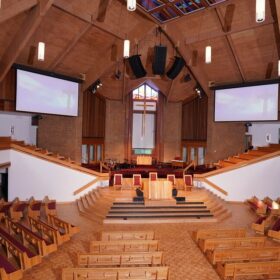Manufacturer News
Optimizing In-Person Worship Service Experiences
How audio-over-Wi-Fi assistive-listening systems support houses of worship’s efforts to make the sanctuary a more dynamic experience.
 In a recent article that appeared in Christianity Today, author Philip Yancy expressed optimism about worshippers returning to in-person services. Yancy offered reasons why in-person church will never go out of style, despite the expediency and comfort that many church-goers experienced while they attended services from home during the pandemic.
In a recent article that appeared in Christianity Today, author Philip Yancy expressed optimism about worshippers returning to in-person services. Yancy offered reasons why in-person church will never go out of style, despite the expediency and comfort that many church-goers experienced while they attended services from home during the pandemic.
Watching services from one’s living room, in a bathrobe, with coffee in hand, is admittedly convenient. However, Yancy notes, “embodied gathering” — whether at a temple, church, mosque, or synagogue — offers community, a sense of belonging and a way of showing up for one another. People inherently crave these things.
Congregants Coming Back In the work I do, I see evidence that supports Yancy’s optimism. Houses of worship are eagerly welcoming back congregants, and they want to offer a positive experience for those who are returning to in-person services. Many updated their AV systems during the pandemic, optimizing streaming and video services so they could stay connected with congregants remotely.
They also want congregants who attend in-person services to hear and see as easily as they can online, while simultaneously enjoying the benefits of connectedness and community. They aim to make the sanctuary a more dynamic experience and ensure that everyone can hear clearly and engage fully.
Many houses of worship inquire about adding or upgrading an assistive-listening solution. Increasingly, they are interested in audio-over-Wi-Fi technology as a convenient, reliable way to accommodate large numbers of users. There are several benefits of this type of assistive-listening system in worship settings. We’ll explore those benefits in turn.
Audio-over-Wi-Fi Assistive Listening Accessibility promotes inclusion: In houses of worship that have audio-over-Wi-Fi assistive-listening systems, users can stream church audio to their smartphone and listen through headphones or a headset. If users wear Bluetooth-enabled hearing aids, sound is transmitted directly from their smartphone to their hearing aids. With the prevalence of smartphones and smart devices, audio-over-Wi-Fi technology democratizes assistive-listening systems.
